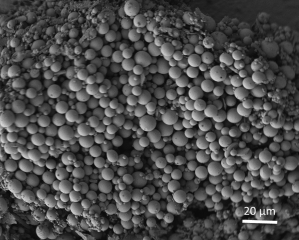Researchers with the University of Florida and several other institutions have found a way in laboratory tests to use 200 times less insecticide and yet still kill as many insects that carry the devastating citrus greening bacterium.
 A scanning electron microscope photo of polymer molecules impregnated with imidacloprid, a common insecticide used to kill the Asian citrus psyllid. Photo by Lukasz Stelinski, UF/IFAS
A scanning electron microscope photo of polymer molecules impregnated with imidacloprid, a common insecticide used to kill the Asian citrus psyllid. Photo by Lukasz Stelinski, UF/IFAS
It is a step forward in ridding groves of the insect that is threatening to destroy Florida’s $10.7 billion citrus industry.
Lukasz Stelinski, an associate professor with UF’s Department of Entomology and Nematology, used a commercial formulation of imidacloprid, a standard insecticide used in the industry to kill the Asian citrus psyllid, among many other pests. He and the team impregnated nano-dispensers, which are microscopic molecules that can contain liquids and then penetrate leaf and bark surfaces.
Using less insecticide could mean saving tens of thousands of dollars for small growers, a make-or-break figure for those who are struggling with stunted production and less or no profit due to the disease.
“During the past 15 years, an explosion in research in micro and nanotechnologies has led to the development of a variety of techniques that allows control of matter at microscopic levels never before seen,” said Stelinski, who works at the Citrus Research and Education Center, a unit in the University of Florida’s Institute of Food and Agricultural Sciences. “They have opened a new era in delivery of pesticides through the development of micro and nanosize controlled release systems.”
Polymer molecules are being employed for these nano-dispenser systems because scientists can change their size, depending on the use needed. They are compatible with living organisms, have a low cost and are about 500 times smaller than a human eyelash. Both synthetic and natural polymers play an essential role in most people’s lives every day, ranging from familiar synthetic plastics, such as disposable cutlery, to natural biopolymers like DNA and proteins - fundamental to human life.
Using insecticides is one of the few ways farmers currently have to treat their groves for greening, also known as Huanglongbing or HLB.
Citrus greening bacterium first enters the tree via the psyllid, which sucks on leaf sap and leaves behind greening bacteria. The bacteria then move through the tree via the phloem – the veins of the tree. The disease starves the tree of nutrients, damages its roots and the tree produces fruits that are green and misshapen, unsuitable for sale as fresh fruit or, for the most part, juice.
Most infected trees eventually die, and the disease has already affected millions of citrus trees in North America. It has recently been found twice in California.
Citrus greening was first detected in Florida in 2005. The citrus industry in Florida has lost approximately 100,000 citrus acres and $3.6 billion in revenues since 2007, according to researchers with UF/IFAS.
Although current methods to control the spread of citrus greening are limited to the removal and destruction of infected trees and insecticide-based management of psyllid populations, UF/IFAS researchers are working to defeat it on a number of fronts, including trying to reduce populations of the psyllid, breeding citrus rootstock that shows better greening resistance, and testing treatments that could be used on trees.
Stelinski’s team experimented with the nano-dispensers in the lab, replicating each treatment experiment five times. In the most successful version of the experiment, 80 percent of the psyllids were dead after 10 days. Researchers also said that less insecticide could have beneficial environmental impacts.
Further field tests are necessary to see how the nano-dispensers perform in sunlight, varying temperatures and humidity levels.
Other members of the team include Wendy Meyer with UF’s entomology and nematology department at CREC, Pablo Gurman, with the University of Texas at Dallas’ Department of Materials Science and Engineering, and Noel Elman, with the Massachusetts Institute of Technology’s Institute for Soldier Nanotechnologies. The research was recently published in the journal Green Chemistry and can be found at http://pubs.rsc.org/en/content/articlepdf/2015/gc/c5gc00717h
Source: Lukasz Stelinski, 863-956-8851 FREE, [email protected]
Disclaimer: The views expressed here are those of the author expressed in their private capacity and do not necessarily represent the views of AZoM.com Limited T/A AZoNetwork the owner and operator of this website. This disclaimer forms part of the Terms and conditions of use of this website.